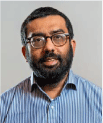Session 5. Oral Presentation for: A feasibility study of Boree Salt body mapping in the Adavale Basin using passive seismic data
Asrar Talukder A *A

Dr Asrar Talukder is a Senior Research Scientist at CSIRO. He completed his PhD at the University of Granada in Spain in 2003. From 2004 to 2007, he worked as Postdoctoral Research Fellow at the GEOMAR Helmholtz Centre for Ocean Research at Kiel, Germany. In late 2007, he joined CSIRO Energy based in Perth. His main research interests have been submarine natural seep plumbing systems; seabed processes associated with the seeps; and how hydrocarbons migrate from seeping points on the seabed to the sea surface. His current research focus is geological emission of hydrogen, underground energy storage and seabed impact of decommissioning of offshore oil and gas infrastructure. |
Abstract
Presented on Tuesday 21 May: Session 5
Hydrogen plays a pivotal role in the global energy transition and may require underground storage. So far salt cavern storage is the only proven technology for underground hydrogen storage. The Boree Salt in the Adavale Basin, mostly at depths from 1 to 2.5 km and up to 550 m thick, consists predominantly of halite and is deemed suitable for hydrogen storage. However, current maps are inadequate. Recently passive seismic data (ambient noise) have received much interest for subsurface imaging. The main signal from passive data is surface waves (usually below 2 Hz). The capability of surface waves for the Boree Salt body mapping is examined. Parameters of seismic sensor spacing, the dominant frequencies of the surface waves, and data noise levels are all considered. It is demonstrated that surface waves from ambient noise can map the Boree Salt bodies with a survey distance of ~40 km. Between frequencies of 0.12 and 0.25 Hz, results from the latter have better resolution because of a shorter wavelength. Moving to higher frequencies of 0.5 and 1 Hz, however, the resolution becomes worse, because the depth sensitivity of surface waves moves to the shallower part of the model with increasing frequencies, rendering them incapable of effectively probing the targeted depths. For signal/noise ratio above five, station spacing can be as large as 1 km without compromising quality. Therefore, cost-effective and environmentally friendly passive seismic data can be a good alternative to the traditional active-source data for deep salt body imaging.
To access the Oral Presentation click the link on the right. To read the full paper click here
Keywords: Adavale Basin, Boree Salt, elastic wave equation, full waveform inversion, hydrogen, passive seismic, subsurface imaging, surface wave.
 Dr Asrar Talukder is a Senior Research Scientist at CSIRO. He completed his PhD at the University of Granada in Spain in 2003. From 2004 to 2007, he worked as Postdoctoral Research Fellow at the GEOMAR Helmholtz Centre for Ocean Research at Kiel, Germany. In late 2007, he joined CSIRO Energy based in Perth. His main research interests have been submarine natural seep plumbing systems; seabed processes associated with the seeps; and how hydrocarbons migrate from seeping points on the seabed to the sea surface. His current research focus is geological emission of hydrogen, underground energy storage and seabed impact of decommissioning of offshore oil and gas infrastructure. |


